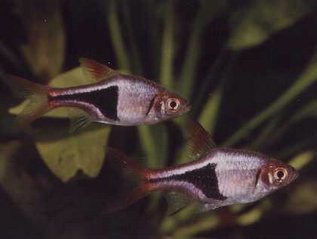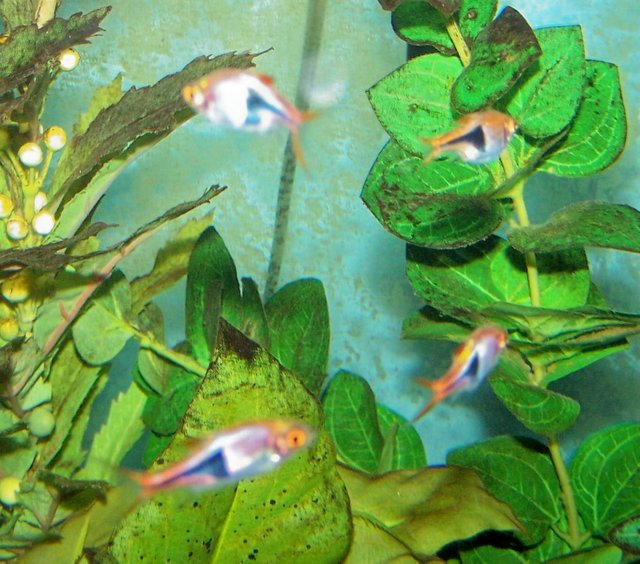| Data Sheet | 
| | Scientific Name: | Rasbora Heteromorpha | | Other Name: | Red Rasbora | | Family: | Cyprindae | | Origin: | Southeast Asia (Thailand, Malaysia) | | Adult Size: | 1.7inches (4.5cm) | | Social: | Peaceful social fish | | Lifespan: | 6 years | | Tank Level: | Mid Dweller |

| | Minimum Tank Size: | 10 Gallons | | Diet: | Omnivore | | Breeding: | Egg Layer | | Care: | Easy | | Ideal pH: | 5-7 | | Temperature: | 72-83F (23-28C) | | Tank setup: | Some space for open swimming and dense plants for shelter | | Sexing: | Females are usually deeper than the males and when ready to spawn has a deeper gold coloration |
|
|



| Description: For a Rosbora, the body shape for Harlequins is unusual in that it is quite deep compared to other Southeast Asian Rosbora. It's body is a reddish metallic (copper?) in color and in some places, it is named Red Rosbora. The most striking feature of this fish is the blue-black triangular wedge in the lower half of the body. Habitat/Care: Harlequin Rasboras can be found throughout the lowland waters of Southeastern Asia, where the water is soft and acidic. They prefer an environment with dense vegetation for shelter, an open area for swimming, a dark substrate (helps to encourage mating), and subdued lighting.
Because they are from Southeast Asia, where the water is warmer, they require water that is between 74 and 78 F (23 -26 C). They are most comfortable in a school, and should be kept in groups of at least four or more.
Mixing with other fishes:Harlequins make excellent community fish, and will not nip at, or quarrel with any other species. Good community fish for it includes neon tetras, rummynose tetras, guppies and other similar size fishes. | Diet: Harlequins are omnivorous and readily accept any accept flake, dried, frozen, and live foods. A varied diet will ensure that digestive problems does not occur. Breeding:Groups of young Harlequins may be bred in a single aquarium. When spawned in groups, two males should be kept for every female. Optimum water temperatures are between 76 and 80 degrees F, and the breeding tank should be planted with broad leafed plants.
Spawning will usually being in the morning, and is initiated by the male dancing before the female. This spawning behavior is intended to direct the female beneath a suitable plant for depositing the eggs. The male may be seen nudging the females sides and rubbing his belly against her back in an effort to move her to the spawning location.
When ready to spawn, the female will turn upside down and rub her belly against the underside of the leaf, signaling the male to join her. The male will approach her while continuing to dance, then wrap himself around her body and fertilize the eggs as they are released. The fertilized eggs rise and adhere to the underside of the leaves. Over the course of one to two hours, as many as one hundred eggs may be laid. When spawning is complete, the breeding stock should be removed from the aquarium, as they will consume the fry once they hatch. In water temperatures of 80 degrees F, the eggs will hatch in approximately twenty-four hours. Fry should be fed food suitable for fries (usually microgram food), and gradually moved to larger foods as they grow in size. Young reach sexual maturity in approximately six to nine months. |
Photo GalleyGot a photo? Contact me. 
References Cited:1. Bad Man's Tropical Fish, Rosabora Heteromorpha, [Online], Available http://badmanstropicalfish.com/profiles/profile25.html
2. Shirlie Sharpe, Harlequin, [Online], Available, http://freshaquarium.about.com/cs/cyprinids2/p/harlequin.htm
3. Aquatic Hobbyist - Caring for your Aquaria [Online], Available, http://www.aquatic-hobbyist.com/profiles/freshwater/cyprinids/harlequinrasbora.html
4. David Goodwin [2001], The Aquarium Fish Handbook, SilverDale Books, UK.
5. Kelvin K P Lim and Peter K L Ng, A guide to common freshwater fish of Singapore, [Online], Available http://habitatnews.nus.edu.sg/guidebooks/freshfish/text/203.htm |





























